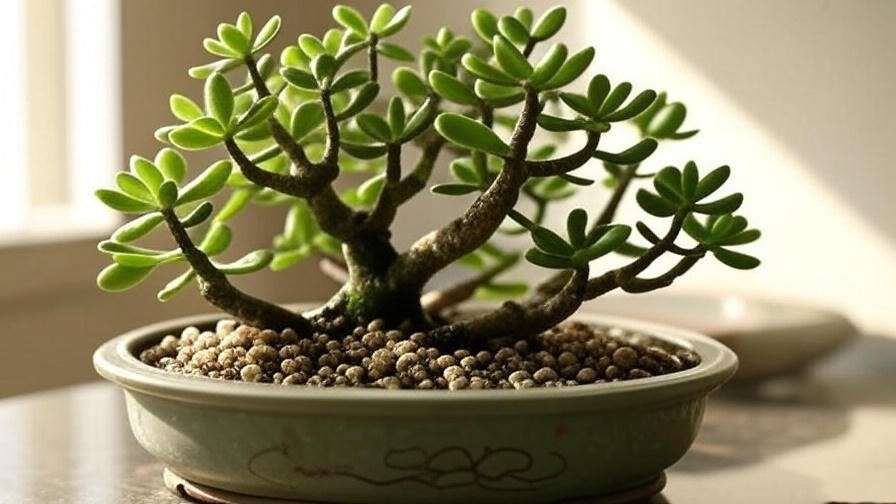Imagine a miniature tree that brings tranquility, beauty, and a touch of nature to your home, all while being surprisingly easy to care for. Meet the jade tree bonsai, a stunning succulent that’s perfect for beginners looking to dive into the art of bonsai. Known scientifically as Crassula ovata, this plant’s thick, glossy leaves and sturdy, woody stems make it an ideal candidate for bonsai cultivation. Whether you’re a plant enthusiast or a complete novice, this guide will walk you through everything you need to know to grow a thriving jade tree bonsai. From light and watering to pruning and troubleshooting, we’ve got you covered with expert-backed tips to ensure your bonsai flourishes. 🌱
With insights drawn from years of succulent care and bonsai expertise, this comprehensive guide is designed to help you avoid common pitfalls and cultivate a healthy, beautiful jade bonsai that enhances your space. Let’s explore why this plant is a beginner’s dream and how you can master its care with confidence.
Understanding the Jade Tree Bonsai 🌳
What Makes Jade Tree Bonsai Unique?
The jade tree bonsai, derived from the Crassula ovata species, is a succulent native to South Africa. Unlike traditional bonsai trees like pines or maples, jade bonsai are prized for their thick, water-storing leaves and compact growth, which make them forgiving and low-maintenance. Their ability to thrive in arid conditions and adapt to shaping makes them a favorite among bonsai enthusiasts. The plant’s glossy, jade-green leaves and woody stems create a striking miniature tree that mimics the aesthetic of larger bonsai without the intensive care requirements.
This succulent’s slow growth rate—typically 1–2 inches per year—allows beginners to practice pruning and styling without worrying about rapid, overwhelming growth. Its resilience to drought and adaptability to various environments further cement its status as an excellent starter bonsai.
Why Choose a Jade Tree Bonsai for Your Home?
A jade tree bonsai is more than just a plant; it’s a living work of art that fits perfectly in small spaces like apartments, offices, or cozy corners. Its compact size, typically ranging from 6 to 18 inches tall, makes it ideal for desks or windowsills. In many cultures, jade plants symbolize prosperity, good fortune, and positive energy, adding a meaningful touch to your home decor. 🍀
Compared to traditional bonsai species, jade trees require less frequent watering and are less sensitive to environmental changes, making them perfect for those new to bonsai care. Their versatility allows them to thrive indoors or outdoors, depending on your climate, offering flexibility for plant lovers everywhere.
Essential Care Requirements for a Healthy Jade Tree Bonsai 🪴
Light and Placement
Light is the lifeblood of a healthy jade tree bonsai. These succulents thrive in bright, indirect sunlight for 4–6 hours daily. A south-facing windowsill is ideal for indoor jade bonsai, providing ample light without scorching the leaves. If you’re growing your bonsai outdoors, place it in a spot with partial shade to protect it from intense afternoon sun.
Tip: Rotate your bonsai every few weeks to ensure even light exposure, preventing lopsided growth. Avoid low-light areas, as insufficient light can cause leggy, stretched stems—a common beginner mistake. If natural light is limited, consider supplementing with a grow light to mimic ideal conditions.
Watering the Right Way
Watering a jade tree bonsai is all about balance. As a succulent, it stores water in its leaves, making it drought-tolerant and prone to overwatering issues. Water thoroughly every 1–2 weeks, allowing the soil to dry out completely between sessions. Use the “soak and dry” method: pour water until it drains from the pot’s bottom, then wait until the soil is bone-dry before watering again.
Expert Insight: Overwatering is the leading cause of jade bonsai failure. Look for signs like soft, mushy leaves (overwatering) or shriveled, wrinkled leaves (underwatering) to adjust your routine. In winter, reduce watering frequency as the plant’s growth slows.
Soil and Potting
A well-draining soil mix is critical for jade tree bonsai health. Opt for a cactus or succulent potting mix combined with perlite or coarse sand in a 1:1 ratio to ensure proper drainage. Avoid heavy, water-retaining soils, as they can lead to root rot.
Choose a shallow bonsai pot with drainage holes to promote healthy root growth and prevent waterlogging. Repot your jade bonsai every 2–3 years in spring to refresh the soil and encourage growth. During repotting, trim any overly long or damaged roots to maintain a compact root system.
Pro Tip: Add a layer of decorative pebbles on the soil surface for an authentic bonsai aesthetic while aiding moisture retention.
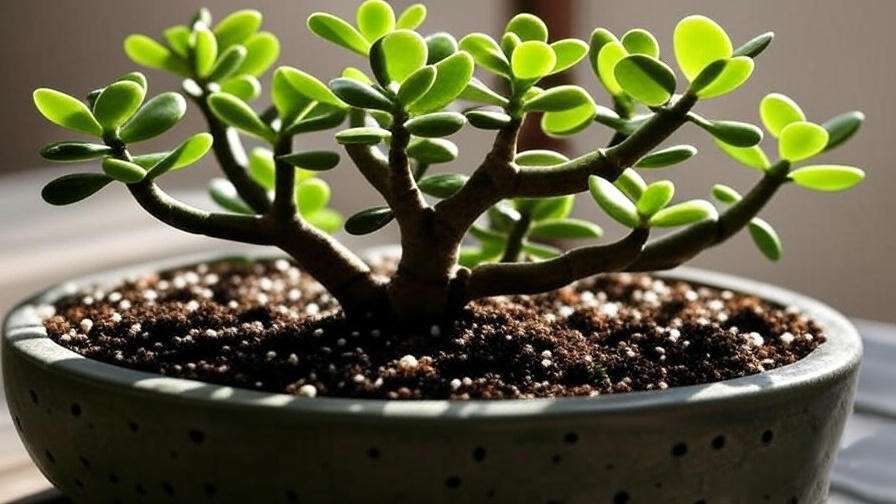
Temperature and Humidity
Jade tree bonsai prefer temperatures between 65–75°F (18–24°C) and can tolerate brief dips to 50°F (10°C). Protect your plant from frost, as cold temperatures can damage its succulent leaves. Low humidity is not a concern, as jade plants are adapted to arid environments, making them perfect for typical indoor conditions.
In summer, ensure good ventilation to prevent heat stress, especially if your bonsai is outdoors. In winter, keep it away from cold drafts or heating vents, which can dry out the leaves.
Fertilizing for Optimal Growth
To keep your jade tree bonsai thriving, fertilize monthly during the growing season (spring and summer) with a balanced, water-soluble fertilizer (e.g., 10-10-10) diluted to half strength. Avoid fertilizing in fall and winter when the plant is dormant to prevent root burn.
Expert Advice: Over-fertilizing can harm your bonsai, causing leaf drop or weak growth. Always err on the side of caution and use less fertilizer than you think you need. A healthy jade bonsai will reward you with vibrant, glossy leaves.
Pruning and Shaping Your Jade Tree Bonsai ✂️
Pruning for Health and Aesthetics
Pruning is essential for maintaining your jade tree bonsai’s shape and health. Regular pruning encourages compact growth, prevents legginess, and enhances the plant’s miniature tree appearance. Use clean, sharp bonsai shears or scissors to remove dead leaves, overcrowded branches, or leggy growth.
Step-by-Step Pruning Guide:
- Identify areas with excessive growth or dead foliage.
- Trim back to a leaf node to encourage branching.
- Remove no more than 20–30% of the plant at a time to avoid stress.
- Prune in spring or early summer when the plant is actively growing.
Tip: Save healthy cuttings for propagation to grow new jade bonsai plants.
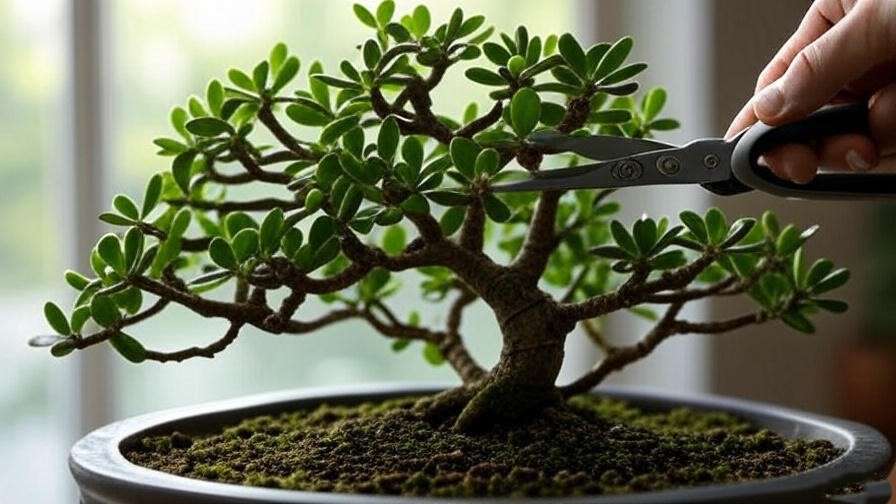
Wiring and Styling Techniques
Wiring allows you to shape your jade tree bonsai into classic bonsai styles like informal upright or cascade. Use soft aluminum wire to gently wrap branches, guiding them into your desired shape. Be cautious, as jade stems are brittle and can snap if bent too forcefully.
Beginner-Friendly Styles:
- Informal Upright: Mimics a natural tree with a slightly curved trunk and balanced branches.
- Cascade: Branches flow downward, resembling a tree growing over a cliff.
Safety Tip: Check wires every few weeks and remove them once the branch sets to avoid scarring. For beginners, start with minimal wiring and focus on pruning to build confidence.
Common Styling Mistakes to Avoid
- Over-Pruning: Removing too much foliage can weaken the plant. Stick to small, incremental cuts.
- Ignoring Natural Growth: Work with the jade’s natural structure for a harmonious design.
- Expert Advice: Study bonsai design principles, such as balance and proportion, to create a visually appealing tree. Resources like the American Bonsai Society offer excellent guides for beginners.
Troubleshooting Common Jade Tree Bonsai Problems 🩺
Leaf Drop and Yellowing
Leaf drop is a common issue for jade tree bonsai beginners, often caused by overwatering, insufficient light, or temperature fluctuations. To diagnose the problem:
- Overwatering: Check for soft, mushy leaves or soggy soil. Reduce watering and improve drainage.
- Insufficient Light: Move the plant to a brighter spot or use a grow light.
- Temperature Stress: Ensure the bonsai is kept within the ideal 65–75°F range.
Prevention: Monitor your care routine weekly and adjust based on the plant’s response.
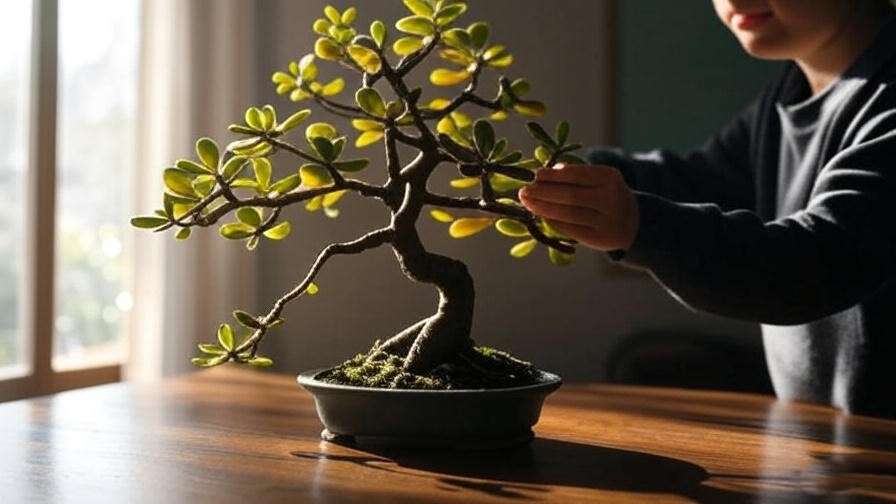
Pests and Diseases
While jade tree bonsai are relatively pest-resistant, they can attract mealybugs, spider mites, or scale insects. Inspect leaves regularly for white, cottony spots (mealybugs) or tiny webs (spider mites). Treat infestations with neem oil or insecticidal soap, and isolate the plant to prevent spreading.
Fungal issues are rare but can occur in overly damp conditions. Improve air circulation and ensure proper drainage to prevent mold or root rot.
Case Study: A beginner noticed white spots on their jade bonsai. By applying neem oil weekly and moving the plant to a brighter, airy spot, they eliminated mealybugs within a month.
Slow Growth or Stunted Development
If your jade bonsai isn’t growing, it may be root-bound, nutrient-deficient, or lacking light. Check the roots during repotting—if they’re circling the pot, trim them and repot in fresh soil. Ensure you’re fertilizing appropriately and providing enough sunlight.
Fixes:
- Repot every 2–3 years to refresh soil.
- Use a balanced fertilizer during the growing season.
- Relocate to a brighter spot if growth is sluggish.
Advanced Tips for Long-Term Success 🌟
Propagating Your Jade Tree Bonsai
Propagating jade tree bonsai is a rewarding way to expand your collection or share with friends. You can propagate using leaf or stem cuttings:
- Leaf Cuttings: Remove a healthy leaf, let it callous for 1–2 days, and place it on moist soil.
- Stem Cuttings: Cut a 3–4-inch stem, let it dry, and plant in a well-draining mix.
- Care: Keep soil slightly moist and place in bright, indirect light. Roots may take 2–4 weeks to form.
Success Tip: Patience is key—don’t disturb cuttings while they root.
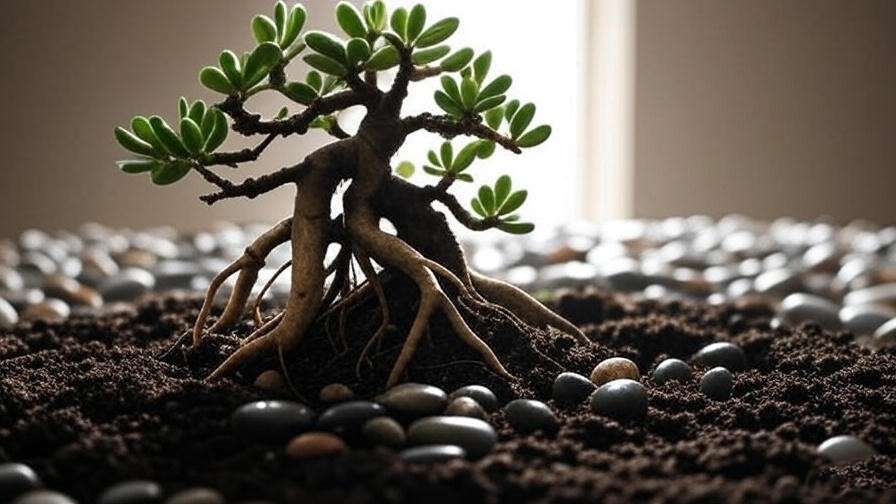
Seasonal Care Calendar
To keep your jade bonsai thriving year-round, follow this seasonal care guide:
- Spring: Prune, repot, and begin fertilizing as growth resumes.
- Summer: Monitor watering closely and protect from intense heat.
- Fall/Winter: Reduce watering and keep away from cold drafts.
Resource: Download our free seasonal care checklist [link to be added] for a handy reference.
Creating a Stunning Display
Elevate your jade tree bonsai’s aesthetic by pairing it with a decorative bonsai pot or stand. Add pebbles, moss, or miniature figurines to create a natural landscape effect. For a cohesive look, group your jade bonsai with other succulents or small bonsai trees.
Expert Tip: Choose a pot color that complements the jade’s green leaves, such as earthy tones or glazed ceramics, to enhance visual appeal.

FAQs About Jade Tree Bonsai Care ❓
- How fast does a jade tree bonsai grow? Slowly, about 1–2 inches per year with proper care, making it easy to maintain.
- Can I keep my jade bonsai indoors year-round? Yes, as long as it gets enough light. Occasional outdoor time in warm weather can boost growth.
- Why are my jade bonsai leaves falling off? Likely due to overwatering or low light. Adjust your care routine accordingly.
- How do I make my jade bonsai look fuller? Regular pruning and pinching encourage branching and denser foliage.
- Is a jade tree bonsai toxic to pets? Mildly toxic; keep out of reach of cats and dogs to avoid digestive issues.
Conclusion: Your Journey to a Thriving Jade Tree Bonsai 🌱
Growing a jade tree bonsai is a rewarding journey that combines creativity, patience, and a love for nature. By providing the right light, watering sparingly, pruning thoughtfully, and troubleshooting issues promptly, you’ll cultivate a stunning miniature tree that brings joy for years. Start with these beginner-friendly tips, experiment with shaping, and watch your bonsai thrive.
Ready to begin? Share your jade bonsai journey in the comments below or join our plant care community for more expert advice. With dedication and these proven strategies, your jade tree bonsai will become a beautiful centerpiece in your home. 🌿

